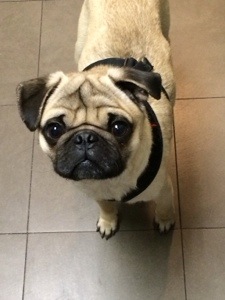 Our clinic works closely with a house-call vet in Manhattan. Since she doesn’t have an office, we take in a lot of her patients that need inpatient care. About two months ago, we took in a rescue dog that one of her clients had told her about. A 3-year-old pug named Earl who had been found in South Carolina, emaciated and covered in fleas. We took him in.
Our clinic works closely with a house-call vet in Manhattan. Since she doesn’t have an office, we take in a lot of her patients that need inpatient care. About two months ago, we took in a rescue dog that one of her clients had told her about. A 3-year-old pug named Earl who had been found in South Carolina, emaciated and covered in fleas. We took him in.
After he was with us a week, he began having violent seizures. Two to three minutes long, full-body convulsions, foam seeping out of his mouth. It all became clear why such a beautiful dog had been thrown to the street. With a combination of medications, we got his condition regulated. But they had left him a little handicapped, mentally. He just wasn’t smart. He’d sit in his cage, kind of staring off into space. He’d chase his tail for a long time, getting to the point where he’d grab it with his mouth and stand still, unsure what to do next.
Over the last couple of weeks, we let him out of his cage more and more, to the point where we set up a little bed for him in the treatment area, and we kept him out with us all day. Every once in a while, he’d have a day with clusters of seizures, but for the most part, he seemed fine.
This last weekend, it was a little bit slower, and we all spent so much time playing with him in the slightly warmer weather, cuddling with him indoors. He had one of the best Pug temperaments. Docile and loving, content to just be held. I fell head over heels in love with him. Even though I don’t live in a situation where I could have a dog, I fantasized about adopting him, taking him home, making him my own. At the end of my shift on Saturday, I held him in my lap, petting him, and I whispered to him, “You’re such a good boy. I promise we’re going to find you a good home.”
Then yesterday, on my day off, I get the staccato texts from Dr. L. Earl isn’t doing well. He’s having so many seizures. His temperature is 108. He looks bad. And finally, the one I was dreading, they had euthanized him. I sat alone in my apartment and wept for a dog that was never mine, but who I loved as much as if he were.
Today was a difficult day. It was busy, but in our down time, we’d look to Earl’s empty corner and talk about how much we all missed him. We do this to ourselves over and over again. We let ourselves get attached to them. I don’t understand how we keep doing it.
It’s easy to build up a wall against this sort of pain, to distance oneself from the possibility of getting attached, to falling in love. But then there are special souls out there who know how to find their way in to a blocked off heart. Earl was one of those.




